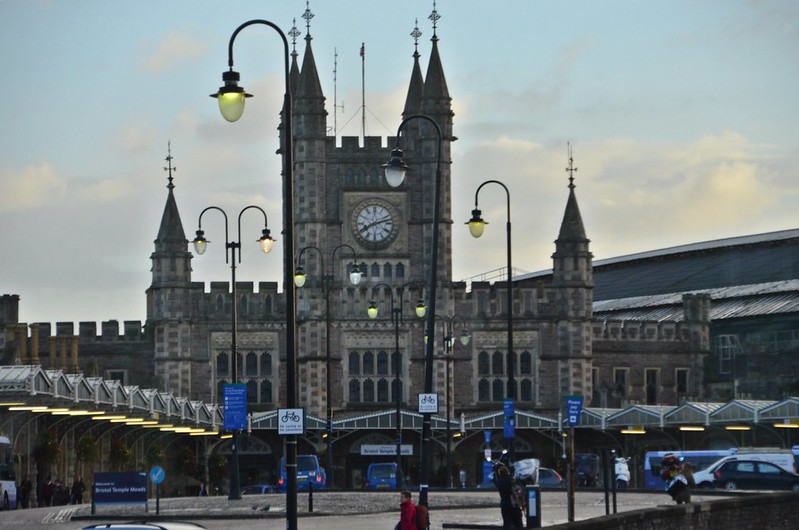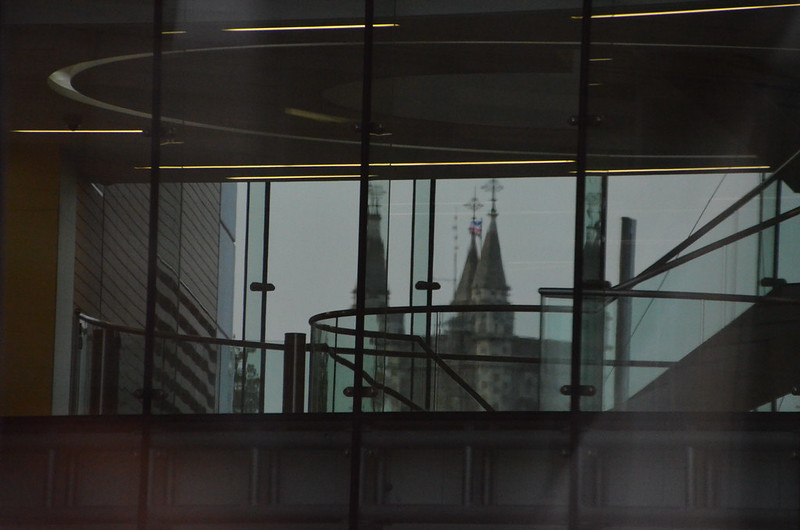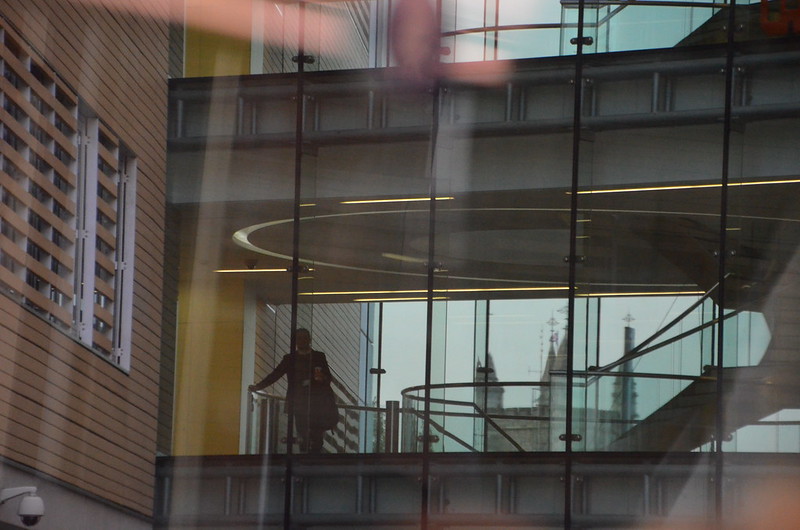
Bristol, UK--we spent the night there and then boarded the coach for the next part of our adventure. Tour Director Anna pointed out the Clifton Suspension Bridge as we rode beneath it--it's 245 feet above water level with a span of 702 feet from one side to the other. Here's a quick photo taken through the coach window--it was our turn to sit on the back row of seats which worked out very well. From the Internet: The Clifton Suspension Bridge opened in 1864, spanning the Avon Gorge and the River Avon . . . The bridge is built to a design by William Henry Barlow and John Hawkshaw, based on an earlier design by Isambard Kingdom Brunel . . . The bridge carries four million vehicles per year, along part of the B3129 road.

When we got out of the coach to take a look at the SS Great Britain on the River Avon, despite the wonderful sunshine, a cold wind blew vigorously so that I couldn't stay out there very long. The sun was in the wrong place, too, so I used the HDR alteration on this photo to enable you to see the ship better. I wish we'd had time to tour this beauty, but as often happens on tours, choices have been made and there just isn't time available as you might wish, but a tour is still a great event to enjoy. Read online about this unique ship: SS Great Britain is a museum ship and former passenger steamship, advanced for her time. She was the longest passenger ship in the world from 1845 to 1854. She was designed by Isambard Kingdom Brunel for the Great Western Steamship Company's transatlantic service between Bristol and New York. While other ships had been built of iron or equipped with a screw propeller, Great Britain was the first to combine these features in a large ocean-going ship. She was the first iron steamer to cross the Atlantic, which she did in 1845, in the time of 14 days.
When launched in 1843, Great Britain was by far the largest vessel afloat. However, her protracted construction and high cost had left her owners in a difficult financial position, and they were forced out of business in 1846 after the ship was stranded by a navigational error.
Sold for salvage and repaired, Great Britain carried thousands of immigrants to Australia until converted to sail in 1881. Three years later, she was retired to the Falkland Islands where she was used as a warehouse, quarantine ship and coal hulk until scuttled in 1937.
In 1970, Great Britain was returned to the Bristol dry dock where she was built. Now listed as part of the National Historic Fleet, she is an award-winning visitor attraction and museum ship in Bristol Harbour, with 150,000–170,000 visitors annually. . . . By 1998, an extensive survey discovered that the hull was continuing to corrode in the humid atmosphere of the dock and estimates gave her 25 years before she corroded away.
Extensive conservation work began which culminated in the installation of a glass plate across the dry dock at the level of her water line, with two dehumidifiers, keeping the space beneath at 20% relative humidity, sufficiently dry to preserve the surviving material.

Here's another building I'd love to have seen up close. However, I am pleased with this photo that I took through the bus window, shocked at the fact that there are no reflections in it. Here's what I read online about the Temple Meads Train Station:
Trains and railways ... the United Kingdom is full of them; whether or not they are on time and are appealing is another matter all togther. Railways are both evidence and the fuel of industrialization. For about a hundred years, this country dominated the world and its railways played a great part as they brought the whole country together. The Great Western Railway was a grand piece in the puzzle. Its terminus was called Temple Meads in Bristol, which happens to be the oldest one in the world.
The magic hand behind Temple Meads station was Isambard Kingdom Brunel. He played a major part in so many areas of transportation that it is hard not to see why he is considered one of the most renowned engineers in the world. Any self-respecting terminus needs to be imposing and welcoming at the same time. Temple Meads fulfils that requirement and more. It is located a mile southeast of the city centre, and makes its northern cousin, Bristol Parkway, look small in comparison. The station has two entrances/exits, so to speak, through which trains depart depending on if they are going to Cornwall or not. There are fourteen platforms, but no number 14. An interesting story probably lies behind that one.
Now where does the name come from? If you look around, you will see the Temple Church, also called the Holy Cross Church. The Templar Knights built it in the XIIth Century. During World War II, it was badly damaged by bombing. The term "Meads" might come from the fact that the cattle market was nearly. The 1950s and 1960s were a period of urban regeneration; so many changes were made to the district, including the station.
Brunel chose a wonderful location: facing the Floating Harbour. The terminus saw its first train leave to Bath on 31 August 1840 and to London Paddington a year later. Brunel was only 34. His original station was transformed into the Empire and Commonwealth Museum in 1999. The main train area is over 21 metres (72 feet) wide. Its roof is a wooden box frame with cast-iron columns supporting Tudor arches. The columns have the appearance of hammerbeams, which are usually seen in open wooden roofs. The design gives the illusion of greater height.
Standing close to Brunel's station was the Bristol and Exeter Railway built in 1844. It was torn down as its layout and size was probably judged insufficient for the expected train traffic. One of Brunel's former colleagues, Matthew Wyatt, built a new station between 1871 and 1878. He then extended Brunel's original station so that the two were joined together. A lot of cargo was carried onto boats between the goods yard and the harbour, so he constructed the Bristol Harbour Railway to facilitate this process. In the 1930s, P. E. Culverhouse added two more platforms. In 1965, Brunel's original station was closed down, and the structure linking the two stations was made into a car park. Both stations are deservingly grade I listed as each one played a part in opening up the United Kingdom.

I cannot resist sharing with you the several unique, at least I think they're unique, views of the Temple Meads Station seen through this glassed-in staircase in a modern building.

The man. Is he OK? He looks bent over with exertion. I found myself thinking of scenes on British TV mysteries involving spies and poisonings.

One last photo before we drove away from this location. The man. Upright and OK. Resting? I believe so. It's 7:16 a.m., perhaps he has just started his taking the stairs regimen.

3 comments:
Beautiful shots... but it is that bridge that really stands out. Magnificent!
Lovely photos and pastel color. My guess is that the first photo of the man climbing is James Bond off camera and the second is him on camera
Another great set of shots. I wish I could there one day but I could not take the long flight.
Post a Comment